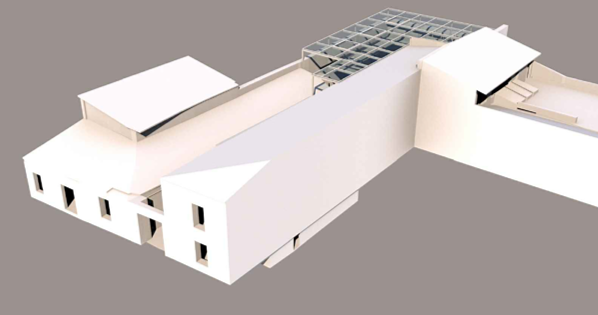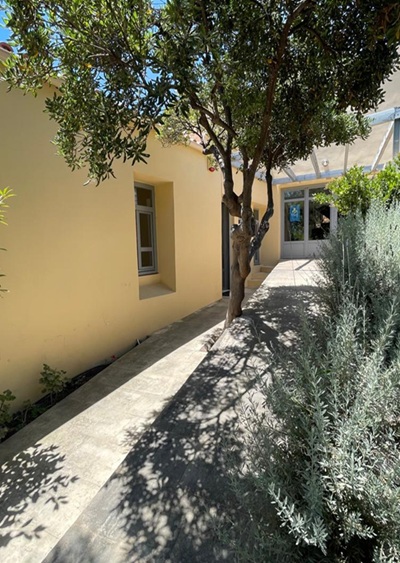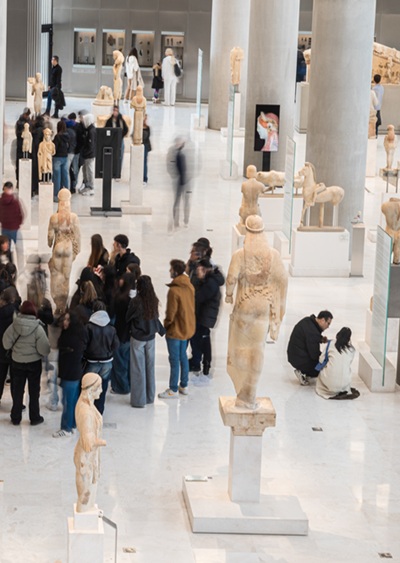
In the course of restoration for its transformation into a museum and cultural space is the historic building of the printing workshop of former “Craft of Greek handkerchiefs” at Metaxourgeio. The Central Council of Modern monuments unanimously gave a positive opinion on the studies for the restoration of the Craft of Greek handkerchiefs monument, as well as on the location of the functions of the multipurpose cultural space as the Museum of typovaphic art and the production of handkerchiefs of Craft of Greek handkerchiefs and the Centre for the handicraft of the fabric.
Procedures for the rehabilitation of Craft of Greek handkerchiefs began in January 2021 with an autopsy of a echelon of the Ministry of Culture led by Lina Mendoni. This was followed by the cleaning of the building and the recording of the archival wealth of the laboratory (drawings, samples, stamps), by the Directorate of modern cultural heritage, and then the necessary studies matured. At the same time, the exploration of collaborations and synergies of Craft of Greek handkerchiefs with other institutions of the modern culture, such as the Center for the study of modern ceramics – G. Psaropoulos’ Family Foundation, the historical Folklore Museum of Larissa, for the production of new stamped fabrics, and the Mendi textile industry –now a branch of the Benaki Museum – in order to create the conditions for the development of the Handicraft Center, which will be organically connected with the Museum of Modern Greek culture and will cooperate closely with the Organization for the management and development of Cultural Resources. In December 2021, the museum Council of the Ministry of Culture unanimously approved the building program, which provides for a permanent exhibition, an archive Space, Administration offices, handicraft.

Αποκατάσταση και αξιοποίηση του κτηρίου της Βιοτεχνίας Ελληνικών Μαντηλιών (ΒΕΜ) στο Μεταξουργείο
This study aims to restore the original features of the building and to highlight its character, turning it into a multifunctional cultural space. Basic synthetic elements in the architectural design are the preservation of the form and development of the wings with minimal functional interventions, the “open space” of the inner courtyard and the construction of an enlightened space on the inner side of the building, where the machines are located. The property is a complex of buildings that were built in different phases during the 20th century. The poor state of preservation of the complex is due to the lack of maintenance, for a long period of time, and mainly to the fact that these are structures that were formed in various phases of the operation of the craft industry, with a poor structure and construction materials.

The building was constructed around 1900 and housed the printing workshop of the Oikonomopoulos brothers, after the transfer of the company from Syros, where it was founded in 1879. It is designated as a historical listed monument along with the equipment and other movable objects. The building is a unique surviving example of pre-industrial production of stamped headscarves, with authentic traditional designs from all over Greece, which were channeled inside and outside Greece during the first half of the 20th century. After 1945 the Craft of Greek handkerchiefs printing office applied the printing of its products with the method of silkscreen printing. The craft industry ceased operations in the mid – 1990s and the property came under the ownership of the Greek state. Wooden seals (stamps, formwork) for the production of printed handkerchiefs, screen printing dies in crates, designs of traditional handkerchiefs, samples of drawings as well as utensils, tools and raw materials for the manufacture of dyes, samples of threads, handkerchiefs and packaging materials, paper material etc.







Leave A Comment